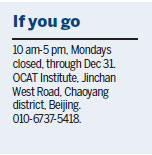Missing parts from Buddha sculptures in Shanxi province digitally restored. Deng Zhangyu reports.
After more than two years of renovation works, the Tianlongshan Caves in North China's Shanxi province reopened to the public earlier this month, displaying its Buddhist sculptures and art.
The renovation project of 10 million yuan ($1.5 million) is expected to help the more than 1,400-year-old caves avoid threats from falling rocks and erosion.
The caves contain some of the finest Buddhist artworks in China. But parts of many sculptures are missing and either in private collections or art institutions abroad, according to the Center for the Art of East Asia at Chicago University.

With the help of 3-D technology, the missing heads of a few Buddha statues from the caves have been reunited with their bodies digitally. The Tianlongshan Caves management worked with the Chicago University for four years on the digital reconstruction of the damaged sculptures housed in 25 caves in Shanxi.
The missing heads have been stolen and sold in the international art market since the 1920s, according to officials from the Tianlongshan Caves management.
An ongoing show at Beijing's OCAT Institute displays the cooperation and shows the caves and completed Buddha statues via 3-D and virtual reality.
The Tianlongshan Caves, nestled on a mountain on the outskirts of Taiyuan, the provincial capital, have about 500 sculptures.
The show displays photos and videos with full Buddha sculptures. For instance, the missing head from a Buddha statue that should have been in Cave No 14, built during the Tang Dynasty (618-907), but is now in the British Museum was scanned and then matched with a 3-D model of the full body in the cave to complete the statue digitally.
"Many of the Buddha heads are outside China - about 150 fragmented sculptures have been located with the aide of CAEA (Chicago University)," says Yu Hao, director of the management office of the Tianlongshan Caves.
He says he has yet to travel to see the missing sculptures displayed in museums, including the Metropolitan Museum of Art in New York, the Tokyo National Museum and the British Museum.
Katherine Tsiang, associate director of CAEA, says since 2013, her team has scanned 103 fragmented sculptures - heads, hands and relief carvings - scattered in the United States, Europe and Japan. But new ones keep emerging.
"We have to continue working on finding them because there're always new ones," she says.
Lin Wei-cheng, who is in charge of communication with museums on the CAEA team, says about 130 pieces were located in 31 places around the world, with Harvard Art Museums displaying the biggest collection with more than 20.
Lin says some art dealers and museums were willing to let the team scan such Buddha sculptures, while others required time to get permission.
It took them two years to get a permission from the Tokyo National Museum to scan Buddha heads stored there.
He says even though they had the data of scanned heads and the management office of the Tianlongshan Caves had that of the bodies, they still failed to restore a complete Buddha sculpture because of missing parts such as the neck.
Yu says except four statues in Cave No 9 that have remained intact, other major sculptures of the Tianlongshan Caves have been damaged.
"The Buddha sculptures are regarded by experts as among the best of those built in the Tang Dynasty," says Yu, who started working at the caves in 1997.
Construction of the Tianlongshan Caves began in the Eastern Wei Dynasty (534-550) when the area of Jinyang was a secondary capital of China. The caves flourished in the Tang Dynasty.
In 1922, articles published by Japanese scholars and photos of the Tianlongshan Caves revealed by Tomura Tajiro, a Japanese art professor, attracted international attention, resulting in a crazy loot of the caves by antique dealers.
The Japanese art dealer Yamanaka Sadajiro, who was then the biggest antique dealer selling Chinese and Japanese art, took 45 Buddha heads in 1926, according to previous media reports.
"To some extent, the Tianlongshan Caves are more known outside China due to the collection in museums across the world," says Yu.
With the digital data of the heads and their separated bodies, he says the management is now preparing a national touring show in 2018 that will display virtually the reconstructed sculptures.
The show is expected to go to the US and Japan in 2019.
Yu says the show will loan sculpture pieces from Chinese collector Xu Peng who bought back a Buddha head auctioned at the Christie's in New York in 2008.
Two other such head sculptures were bought back to the country in 2003 and are now displayed at the National Museum of China.
Contact the writer at dengzhangyu@chinadaily.com.cn
|
Buddha statues are displayed at a Beijing show via 3-D and virtual reality technologies. These are relics from the Tianlongshan Caves in Shanxi province. A file photo (above left) shows the damaged statues in Cave No 14.Photos Provided To China Daily |
(China Daily 08/29/2017 page20)